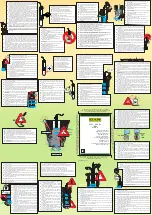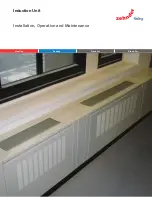
24
MAINTENANCE
Clear dust from the machine at regular intervals, if used in a dirty environment
the machine should be cleaned at least once a month.
Check all connections are clean and tight, if there is any oxidization clean the
connection with a mild abrasive or wire brush.
Check all cables for damage or degradation to the insulation, replace if any is
found.
Check earth clamp condition ensure they clamp tightly, replace if damaged or
loose.
If the machine is not to be used for a long time, store it in the original packing a
dry place.
All consumables in the torch must be checked and cleaned / replaced fre-
quently.
9
SAFETY INSTRUCTIONS….cont
Ventilation must be adequate to remove the smoke and fumes during welding
(see the relevant safety standard for acceptable levels).
Toxic gases may be given off when welding, especially if zinc or cadmium
coated materials are involved, welding should be carried out in a well ventilat-
ed area and the operator should always be alert to fume build-up.
Areas with little or no ventilation should always use a fume extractor.
Vapours of chlorinated solvents can form the toxic gas phosgene when ex-
posed to U.V radiation from an electric arc. All solvents, degreasers and poten-
tial sources of these vapours must be removed from the arc area.
Severe discomfort, illness or death can result from fumes, vapours, heat, oxygen
enrichment or depletion that welding (or cutting) may produce. This will be pre-
vented by adequate ventilation or using a fume extractor.
NEVER
ventilate with
oxygen.
Lead, cadmium, zinc, mercury, beryllium bearing and similar materials when
welded may produce harmful concentrations of toxic fumes. Adequate ventila-
tion must be provided for every person in the area. The operator should also
wear an air supplied respirator, for beryllium both must be used.
Metals coated with or containing materials that emit toxic fumes should not be
heated unless coating is removed from the work surface. The area should be
well ventilated or the operator should wear an air supplied respirator.
Work in a confined space only while it is being ventilated and if necessary whilst
wearing an air supplied respirator.
Gas leaks in a confined space should be avoided, leaking gas in large quanti-
ties can change oxygen concentration dangerously.
DO NOT
bring gas cylin-
ders into a confined space.
Leaving a confined space you must shut off the gas supply at the source to
prevent possible accumulation of gases in the space if down stream valves are
left open. Check to be sure that the space is safe before re-entering it.
VENTILATION
without gloves.
First aid facilities and a qualified first aid person should be available for each
shift unless medical facilities are close by for immediate treatment of flash burns
to the eyes and skin.
Flammable hair products should not be used by persons intending to weld.
Warn bystanders not to watch the arc and not to expose themselves to the
welding arc rays or to hot metal.
Keep children away whilst welding, they may not be aware that looking at an
arc can cause serious eye damage.
Protect other nearby personnel from arc rays and hot sparks with a suitable non-
flammable partition.


































